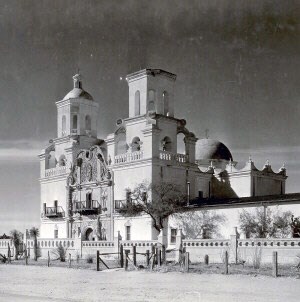
By Ginny Sphar
Father Stiger was born in northern Switzerland in the village of Oberriet near St. Gallen on October 20 or 21, 1695. Ordained on Whitsunday’s Eve, 1719, he served as a parish priest in his native country for more than six years before entering the Society of Jesus on October 9, 1725.[1] Father Stiger came to New Spain on His Majesty’s ship La Potencia, alias El Blandón, in 1730 with a group of 26 missionaries. They sailed into Havana Harbor February 2, 1731. In April they crossed over to Vera Cruz. From there, on muleback they traveled to Mexico. In the group were Stiger, Segesser, Keller and Grazhoffer. Father Stiger was on his way to Cárichic mission among the Tarahumaras.[2] Following Father Grazhoffer’s death at Guevavi, the Father Visitor called Father Gaspar from Tarahumara Alta to fill the vacancy at Bac.[3] Father Segesser from Bac went to Guevavi. On July 31, 1734, Segesser, Keller and Stiger were to celebrate the feast day of Saint Ignatius. However, Father Stiger had been recalled from Bac by the Father Visitor. The two others made ready, but without warning the Indians of Soamca had deserted them; Guevavi’s Indians had taken to the hills; and at Bac, in Stiger’s absence, the natives had broken into his house and stolen everything “including the new, beautiful, and precious vestments in 5 colors and all appurtenances which our Viceroy had given to us when we were sent to those new missions.”[4] Stiger hurried north. This was rebellion. Had the Pimas of the north wished to set back the Spanish advance, this was the time. Now the Jesuit superiors had begun to doubt again if the Pimas could be converted and they feared for the safety of their missionaries.[5] Hearing of the trouble, Captain Anza and his soldiers rushed to the scene. Already the three missionaries had begun negotiating the return of the Indians. The repentant Indians at Bac carried back what they had stolen, although much was broken or torn. The cause of the flight was a rumor that Captain Anza was coming to kill the Pimas. The rumor was started by Spaniards who wished to scare the Indians and turn them against the Padres. From San Xavier, in November, Father Stiger reported that each of the three missionaries was now with his own flock.[6] For a couple of years after Father Segesser left Guevavi, the mission was relegated to the occasional care of an absentee Padre. During 1735, tall, dark-haired Stiger of Bac, who bore the scar of an old wound between his eyebrows, ministered when he could to the needs of the natives of Guevavi yet the compassionate, courageous Father Gaspar, who claimed that he was “wholly content” with his calling, more than had his hands full at San Xavier. Three times the shamans cast curses against him. They would have killed him if it had not been for Father Campos. Even at that, he suffered ill effects for the rest of his life.[7] When the elderly Father Campos was finally dislodged from San Ignacio by order of his superiors,[8] Father Stiger rode from Bac to replace him. For the next 25 years, until his death at 2:00 in the afternoon of April 24, 1762, Father Stiger was Padre of San Ignacio. [1] San Ignacio, Entierros. Pradeau and Burrus, “Los Jesuitas.” [2] Ibid. [3] Ibid. [4] Treutlein, “Relation of Segesser,” MA, XXVII, p. 164. [5] Stiger to Halaver, November 9, 1734. [6] Ibid. [7] San Ignacio, Entierros. Pradeau and Burrus, “Los Jesuitas.” [8] Father Joseph Toral to Father Provincial Joseph Barba, Guépaca, March 25, 1736; WBS, 1747, ff. 25-34. A detailed treatment of Campos’ sad finale is Dunne, “Captain Anza and the Case of Father Campos,” MA, XXIII (1941), pp. 45-60. |
Last updated: May 6, 2025
